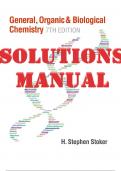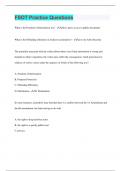,Test Bank for General, Organic, and Biological Chemistry 7th Edition
by Stephen Stoker.
Basic Concepts About Matter Chapter 1
Problem-Set Solutions
1.1 All samples of matter have (1) mass and (2) occupy space.
1.2 Chemists are particularly interested in (1) the characteristics of matter, (2) the composition of
matter, and (3) the transformations of matter.
1.3 Air, pizza, and gold are matter because each has mass and occupies space. Sound is a form of
energy.
a. matter b. matter c. energy d. matter
1.4 a. matter b. matter c. energy d. matter
1.5 a. Liquids have an indefinite shape; solids have a definite shape.
b. Gases have an indefinite volume; liquids have a definite volume.
1.6 a. definite volume b. indefinite shape
1.7 a. Copper wire does not take the shape of its container; yes, it does have a definite volume.
b. Oxygen gas does not have a definite shape nor a definite volume. It takes the shape and
volume of its container.
c. Each granule of sugar has its own definite shape; however, the granules are small, so
the general shape of the mass of crystals does take the shape of the container. Yes,
granulated sugar has a definite volume.
d. Liquid water takes the shape of its container; yes, it has a definite volume.
1.8 a. takes shape of container; no, definite volume
b. takes shape of container; yes, indefinite volume
c. takes shape of container; yes, indefinite volume
d. takes shape of container; no, definite volume
1.9 a. The state of a substance is a physical property.
b. Ignition on heating with air produces a new substance, so this is a chemical property.
c. A new substance is produced (hydrogen gas), so this is a chemical property.
d. Density is a physical property.
1.10 a. physical property b. chemical property
c. physical property d. chemical property
1.11 a. Chemical. The key word is “reacting,” which indicates that a new substance is formed.
b. Physical. Red color can be observed without the formation of a new substance.
c. Chemical. The toxicity of beryllium indicates that it produces a change of
substances in the human body.
d. Physical. Pulverizing a substance changes its shape.
1.12 a. physical b. chemical c. physical d. physical
,2 Problem-Set Solutions Chapter 1
1.13 a. Chemical. The word “reaction” indicates the inability to form a new substance.
b. Chemical. The word “reacts” indicates that a new substance is formed.
c. Physical. Change of state is a physical property.
d. Physical. Change of state is a physical property.
1.14 a. chemical property b. chemical property
c. physical property d. physical property
1.15 a. Physical change. The leaf changes shape, but the crushed leaf is not a new substance.
b. Physical change. The metal has changed shape, but it is not a new chemical substance.
c. Chemical change. Burning is always a chemical change because new substances are
formed.
d. Physical change. The ham changes shape, but it is still ham; no new substance is formed.
1.16 a. physical b. chemical c. physical d. physical
1.17 a. Physical. Mechanical changes are physical.
b. Physical. A change of state, from liquid to solid in this case, is always a physical change.
c. Chemical. The smell of sour milk indicates that a new substance has been formed.
d. Physical. Breaking or cutting is always a physical change.
1.18 a. chemical b. physical c. chemical d. physical
1.19 a. Physical. Ice and liquid water are the same substance in two different forms.
b. Physical. Crushed ice and ice chips are both forms of water; no new substance is formed.
c. Chemical. Burning a newspaper produces a change in its chemical identity; the gases,
charred paper, etc., formed are new substances.
d. Physical. Pulverizing a sugar cube produces a new shape, but the substance is still sugar.
1.20 a. physical b. physical c. chemical d. physical
1.21 a. Chemical change. Burning a newspaper produces new substances.
b. Chemical property. Metallic copper reacts with chlorine gas to produce a new substance.
c. Physical change. Ice melting is a change of state. No new substance is produced.
d. Physical property. The state (solid) of a substance (gold) is a physical property.
1.22 a. chemical change b. physical property c. physical change d. physical property
1.23 a. False. A heterogeneous mixture contains two or more substances.
b. True. A pure substance contains only one substance, and so has a definite composition.
c. False. Substances maintain their identity in all mixtures; they are physically mixed, not
chemically combined.
d. True. Most substances in the “everyday world” are mixtures.
1.24 a. true b. false c. true d. false
1.25 a. Heterogeneous mixture. “Two substances” makes this a mixture; “two phases” shows that
it is not uniformly mixed.
b. Homogeneous mixture. “One phase” indicates that the mixture of two substances has
uniform properties throughout.
c. Pure substance. The two phases present represent two forms of a single substance (for
example, ice and liquid water).
d. Heterogeneous mixture. The existence of three substances in three different phases
indicates that the substances are not mixed uniformly.
, Problem-Set Solutions Chapter 9 3
1.26 a. homogeneous mixture b. pure substance
c. pure substance d. heterogeneous mixture
1.27 a. Homogeneous mixture, one phase. The word “dissolved” indicates that the salt is
uniformly distributed throughout the salt-water mixture.
b. Heterogeneous mixture, two phases. The undissolved sand is not uniformly mixed with the
water.
c. Heterogeneous mixture, three phases. The three phases present are ice (solid), liquid water,
and liquid oil. The two liquids are not soluble in one another; they are separate phases.
d. Heterogeneous mixture, two phases. The water solution (water and dissolved sugar) is one
phase; the undissolved sugar is the other phase.
1.28 a. homogeneous mixture, one phase b. heterogeneous mixture, two phases
c. heterogeneous mixture, three phases d. homogeneous mixture, one phase
1.29 a. Compound. A single substance (A) made up of two elements is a compound.
b. Compound. B must contain more than one element to decompose chemically, so it is a
compound.
c. Classification is not possible because not enough information is given.
d. Classification is not possible. Melting is a physical change that both elements and
compounds can undergo.
1.30 a. element b. classification not possible
c. classification not possible d. classification not possible
1.31 a. For A and B, classification is not possible. C is a compound because it contains the
elements in A and B.
b. D is a compound because it breaks down into simpler substances. It is not possible to
classify E, F, and G.
1.32 a. A, compound; B, classification not possible; C, classification not possible
b. D, classification not possible; E, classification not possible; F, classification not possible;
G, classification not possible
1.33 a. True. An element contains one kind of atoms and so is a single pure substance. A
compound has a definite, constant composition, so it is also a pure substance.
b. False. A compound results from the chemical combination of two or more elements.
c. False. In order for matter to be heterogeneous, at least two substances (either elements or
compounds) must be present.
d. False. Both compounds and elements have a definite composition.
1.34 a. true b. false c. true d. false
1.35 The first box is an analogy for a mixture; the nuts and bolts are not evenly distributed. The
second box is an analogy for a compound; each bolt is attached to a nut.
1.36 First box: mixture; second box: compound
1.37 a. Compound. A compound is a substance that contains more than one element.
b. Mixture. Two substances are “mixed” together; this is a mixture.
c. Element. A substance that cannot be decomposed by chemical means is an element.
d. Mixture. Since the composition is variable, this is not a compound; it is a mixture.






